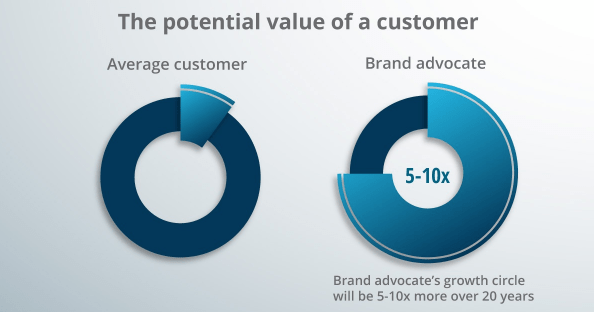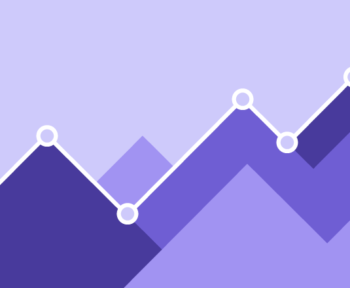With more technology and social media choices, the potential value of brand advocates has increased.
The reality of advocacy today is that if someone is so inclined, there are endless sources of information to promote the brand. Spreading this word today means not only telling a few friends and family but telling the world.
Table of Contents
Who is a brand advocate?
Brand advocates often promote their brand by word of mouth, without external incentives. They are usually customers who have had a great experience with the brand and felt the need to talk about it to others. Brand advocates are valuable because they drive customers to your brand.
Marketers usually list advocacy marketing as the most profitable and cost-effective online marketing method.

Three clear reasons why brand advocates are so important
We want to consider loyal customers as some of the most profitable customers, but further consideration reveals that brand advocates are far more valuable.
Let’s compare the two to get an example of why this is. First, think about your loyal customers. They may buy our products and services every time they need something from our brand industry. After that, this continues throughout their lives.
Now, think that brand proponents will do essentially the same thing. They love our products so much that they buy them in competition as much as possible.
What’s more, they express their positive views on our brand and the new products and services we release. This could potentially lead to more sales and a large number of new customers.
Even if supporters have never purchased from us (although unlikely), they are more valuable than loyal customers.
Why is this? Why are brand advocates so effective in promoting your brand? And how are modern technologies applied? The further breakdown is as follows.
1. The power of social trust

A picture of the moment when an advertisement appears when you are watching TV. Celebrities you know are in favor of new e-readers. They may show that they are using it in a montage, give them some benefits it offers, and suggest why you need it.
Now, think of your close friend having lunch and the topic of the book emerging. They tell you that they have been able to read all these days, depending on how great their electronic readers are.
They explain the various benefits and how they helped them overcome common reading obstacles.
You have some uncertainty about the screen you ask for. They point out that their electronic readers allow for larger fonts to avoid eye strain.
In the above two scenarios, you’re much more likely to buy an e-reader for your friends to use. They trust their friends and value their nominations to celebrities. There are various reasons for this.
The biggest reason is that they know and trust their friends. They respect their opinions and believe in the truth, not just trying to put them up for sale.
Also, the needs of their friends can be similar to their own needs (because most people are not celebrities). Finally, they were able to ask questions about the product on the spot and receive answers.
Brand advocacy isn’t always the difference between celebrity advertising and close friends recommending products, but the power of brand advocacy is still visible.
Even if supporters speak positively to strangers about our brand or product, it is quite possible that they will be given a high level of trust. By convincing us whether a brand is good or bad, it’s much easier to trust a companion who doesn’t get anything.
Now let’s think about how widespread the message of brand supporters will be.
2. Outreach of modern advocacy
To truly understand the potential power of brand advocates, we need to consider the modern reality of technology and social media.
Even the most connected brand advocates in the past have been fairly limited. Indeed, they were able to convey the wonders of the brand to friends, family, and perhaps a few colleagues. And this was absolutely important.
However, it’s not as good as the potential outreach of today’s connected brand advocates. There are many platforms besides friends, family, and colleagues that modern advocates can still recommend.
First, there are social media where users connect with hundreds and thousands of minor acquaintances. There is also an online review platform that allows advocates to potentially recommend brands and rate products in great detail.
It’s not hard to understand that brand proponents have some serious value-how much is the problem?
3. Measurable value of brand supporters
Brand advocates can potentially be far more valuable than the average customer, especially in the long run, depending on their outreach.

It is estimated that more than 80% of customers prefer recommendations from acquaintances to other sources. Combine this with the fact that word-of-mouth recommendations are believed to be the driving force behind over 40% of purchases, and you get a very valuable product.
In today’s world of transparency, brand advocates are one of the best weapons on your side. Websites that provide customer reviews and ratings always remind you that it’s important for someone to admire your brand.
Another lesser-known way for brand proponents to help is to create content without external incentives. Basically, they are creating content that promotes your brand and you don’t even have to pay them.
Since their work is essentially done for them, this creation certainly helps limit the overspending of marketing budgets on content creation.
There are several reasons why brand advocates are so valuable, so make sure you know how to attract new advocates.
A dynamic way to attract supporters of a new brand
It’s pretty clear how important brand proponents are, but how do you create them? I came up with some ways to make sure the trick is done.
Focus on the brand experience
What’s a better way to invite customers to spread good words about their brand than an experience they love and connect with?
The brand experience is memorable and not only lasting but also gives customers a reason to talk about your brand to others.
It’s not too difficult to understand why this is the case. Think about how common it is for someone to tell someone who knows your brand experience.
Maybe the cinema where they took the movie characters in costumes to greet the young people who went in and out of the screening with their children. Sure, they will teach others, especially those with their own children, a good time in the movie.
Think about how your brand can create a unique and memorable experience for your customers. These strong experiences can form a lifelong brand advocate.
Implement compelling brand storytelling

“Storytelling is the most powerful way to bring ideas into the world today.” – Robert McKee
Google search may seem like a common thing today. Users can log on to popular search engines to quickly find answers to questions, new websites, local restaurants, and more. You may not have much thought about what they will search for after the fact.
However, with the genius idea that Google turns annual search into a compelling storytelling campaign, users see search as impactful, meaningful, and important.
The idea is simple. Every year, Google puts together user searches to create YouTube videos that turn the most popular ones into compelling stories. Themes usually emerge and help users lead to the idea that their input builds history.
This type of storytelling helps brands connect with their customers. It gives brands the opportunity to give them valuable insights into what they represent and who they really are. This helps to stand out to the customer.
As we see each year after Google tells its story, there are many plots, connections, hype, and buzz surrounding a powerful brand story.
Do you think your brand has its own story?
Providing quality and reliable products or services
There are many different factors that can help you create a brand advocate. One of them, perhaps the most important foundation, is the quality of the products we offer.
This seems pretty logical, as not all experience with a brand is all if there is a shortage of final products or services. No one intends to recommend a bad product just because customer service is top-notch.
Some customers go one step further and stick to brands they dislike if their products and services are good.
It’s easy to say that the key to gaining brand support is to make great products. Every company is trying to provide a good product. The important thing is to make adjustments based on research until it is appropriate.
Another aspect that cannot be ignored is reliability.
When most people hear reliability, they think it means something that works correctly or is 100% time reliable. Obviously, this is not possible, even for the toughest and most durable products and the most devoted brands.
However, reliability requires a much higher level of responsibility. When a customer is in trouble, a trusted brand responds exactly.
The best way to maintain credibility is to truly listen to your customers and understand how their requirements have changed.
Identify supporters: Encourage advocacy
Do you know why it’s so important to understand who your brand’s supporters are? It is easy to forget that just because an advocate asks a question on our behalf does not mean that we cannot act positively.
Find your brand supporters
When brands know who their supporters are, they can be ahead of the feedback that their next project must receive. For example, if a brand plans to release a new product line within the next three months, the brand can notify and contact supporters about it.
In addition, Brand Advocates are much more eager to provide valuable insights into recent services, helping to build feedback without annoying customers who are reluctant to comment or criticize.
If you need more help in investigating and finding supporters of your new brand, consider a software system such as Hootsuite to handle your workload.
Encourage advocacy
Keep in mind that just because a customer is a supporter of a brand doesn’t mean they can’t move the customer in the right direction to share a little more.
In fact, there are many brand advocates who want to spread your brand message but are limited by accessibility and other factors.
How would you fix this? The simplest answer is to find a unique and creative way to encourage advocacy. For example, some brands reward their recommendations to friends and family.
Nowadays, brands have placed easy-to-share links to digital products and services that further promote advocacy.
Keep in mind that this kind of encouragement only works for those who already want to support your brand. Providing rewards for sharing bad products doesn’t work.
Companies that make advocacy bold
Here are some companies that serve as examples of good strategies for promoting advocacy:
Starbucks

Popular coffee chains have come up with great ideas to generate and potentially identify brand supporters. Their “Tweet-a-coffee” program provided customers with the option of using social media to buy coffee for others.
Part of the reason for this success is that it promotes a sense of social cohesion, which is always a good precursor to the brand’s image.
Another reason this was so positive for Starbucks was that we were able to use social media purchases to identify future brand proponents with whom we could discuss other projects and feedback.
Coca Cola

Coca-Cola is one of the best examples of brands that effectively promote advocacy. There are quite a few campaigns that stand out as a powerful way to create new supporters. Discuss my personal favorites.
This was a really good idea and not only created a sense of unity with many topics as a result but also directly encouraged advocacy. Indeed, it’s a powerful way to disseminate information about your brand to someone.
Another campaign they ran was the “Happiness Machine” project. In this project, a special cola vending machine was installed in a public place, but it intentionally malfunctioned and provided more soda than purchased (actually more).
These moments were captured by cameras and spread over the internet, mostly YouTube. The video showed that people are laughing, sharing, and enjoying the fun brought about by the “errors” of coke machines.
First, there is an ingenious “Share a Coke” campaign that prints the word “Share a Coke with …”, where the common name is printed and the customer buys one of the sodas and a friend, colleague, or they If you share that name, your family.
Final thoughts
If you really want to succeed, marketing intended to create brand advocates should be integrated into your daily marketing process. Think of many ways you can offer your customers a great experience and product, and then move on to encourage advocacy.
Perhaps there are more brand advocates in your potential than you think. As you start looking for them and helping them, they start appearing everywhere. Good luck!
Hope You enjoyed reading this content. Don’t forget to support us by sharing this piece of content. Thank you
You may also read
What is Brand Awareness & How to create Brand Awareness?
Top 14 Tips To Build Social Media Presence
What is crowdsourcing and how it works?






2 Comments
Lee
hello!, I really like your writing so very much! proportion we are in contact extra about your post on AOL?
I need an expert in this house to resolve my problem.
inamdurrani60
Thank You Lee